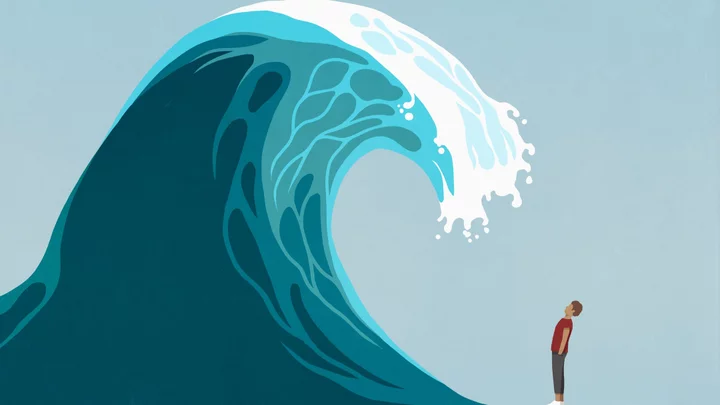Don't look now but existential dread seems to be creeping back into our lives, ready to wreak havoc on our mental health and well-being.
No doubt your social media feeds have documented this sense of despair — and contributed to it — at a breakneck pace.
There's the looming threat of a brutally hot summer partly thanks to climate change, the prospect of yet another mass shooting, ongoing economic uncertainty including last-minute negotiations over raising the debt ceiling, and the fear that marginalized groups feel as they become targets of attacks based on their race, ethnicity, gender identity, or sexuality, among other aspects of who they are.
Each crisis, whether we're anticipating it or living through it, can lead to feelings like anger, helplessness, and anxiety. It's easy to become stuck as these emotions dominate daily life.
But Dr. Luana Marques, author of the new book Bold Move: A 3-Step Plan to Transform Anxiety into Power, believes that if people persist through moments of dread and discomfort, they'll become more capable on the other side.
SEE ALSO: 3 things I learned after meditating for 100 weeks straightMarques, a psychotherapist and an associate professor of psychiatry at Harvard Medical School, takes a well-known technique called cognitive behavioral therapy and distills it into easy-to-follow steps.
She described a brief version of this approach in a conversation with Mashable about how to deal with existential dread:
1. Pause to check in with your body, feelings, and thoughts.
Life in the 21st century affords few moments for genuinely mindful pauses, thanks to the siren call of ever-present devices and digital connectivity. Yet Marques urges her patients to regularly stop what they're doing to consider physical sensations, feelings, and thoughts, all of which may make for an overwhelming combination.
Intentional pauses can be particularly helpful when a scroll through social media, with its seemingly constant drumbeat of bad news, sets off alarm bells in the brain.
Marques says the brain is designed to "protect and predict" at such a rapid clip that it can sometimes mistake bad news or tragedy in the world for a personal life-or-death threat.
Want more stories about social media and mental health in your inbox? Sign up for Mashable's Top Stories newsletters today.
In other words, a mass shooting that happens thousands of miles away might lead someone to feel like they're immediately unsafe. That can start in the body, as blood pressure rises or the throat clenches, which prompts anxiousness or fear. In turn, those feelings may become certain thoughts like, "I know this is going to happen to me soon, too."
While gun violence in the U.S. is a very real problem that legitimately makes millions of people feel less safe, the trick to dealing with the intense dread it can unleash is being aware of that dynamic in the first place.
"Whatever it is that causes discomfort, notice that discomfort, pause, and then really identify what it is you're saying to yourself, how does that make you feel, and what you want to do, before doing anything," says Marques.
Additionally, Marques says that people's responses to these and similar events will depend on their own life experiences. Someone with a history of trauma, or someone who's a gun violence survivor, may have a much different reaction to a mass shooting than an individual without those experiences. But pausing to deal with individual emotions can offer a sense of control that struggling under the weight of them all at once would fail to provide.
2. Don't avoid what you're feeling.
Whether or not someone has identified what exactly they're feeling, there's the constant temptation to respond to a perceived threat by avoiding discomfort. In fact, Marques writes in Bold Move that without proper training "avoidance is a force far more powerful than any of us can handle."
That's because habitual avoidance of discomfort trains the brain to believe the tactic is singularly responsible for delivering relief. Avoidance can look like responding to a perceived threat by reacting, retreating, or remaining in ways that aren't productive, says Marques.
Scrolling social media, for example, can be a way to retreat from whatever is uncomfortable. That might sound counterintuitive in cases where more exposure to news would only lead to further distress, but social media can also generate unexpected whimsy, laughter, or connection that serves to distract from unpleasantness.
Other forms of retreat can include putting off small tasks, exercising excessively, or grabbing a glass of wine. Of course, there's nothing inherently wrong with any of these behaviors, but they can become problematic when they facilitate avoidance.
"Most people...when they start to feel anxiety or discomfort, they jump in avoidance so fast." - Dr. Luana Marques, author of "Bold Move: A 3-Step Plan to Transform Anxiety into Power""Most people...when they start to feel anxiety or discomfort, they jump in avoidance so fast," says Marques. "For us to see reality, we have to tolerate discomfort."
Confronting difficult feelings can feel hard or impossible, but Marques adds that avoiding them only prolongs painful experiences.
There is important nuance to understand about this process, however. Understanding how to handle negative emotions should come with healthy boundaries that are appropriate for someone's own unique situation.
"It's very important to understand the limit for everybody's brain," says Marques.
If avoidance of discomfort is preventing someone from doing something that really matters or is deeply meaningful, then the tactic is not helpful. Think, for example, of limiting most trips to public places out of fear of a mass shooting, which might prevent someone from seeing close friends or pursuing hobbies.
But if the subject of avoidance will only amplify pain, like viewing viral videos of gun violence victims, then it's healthy to maintain boundaries.
"Pain is necessary, suffering is not necessary," says Marques, paraphrasing a well-known Buddhist adage.
SEE ALSO: 33 ways Black people can reclaim their breath3. Do the opposite of what the anxiety wants you to do.
Once someone has identified and acknowledged how their feelings have shaped their thoughts, and effectively calmed their nervous system, Marques says they should do the opposite of what anxiety is prompting them to do.
Oppositional action, which defies the urge that comes with a strong emotion, is critical for getting to the other side of discomfort. This could be as simple as swapping a glass of wine for a five-minute meditation or walk around the block. It might also mean having a tough conversation that's been delayed because it means potential conflict.
Importantly, Marques recommends practicing this technique slowly, and in lower-stakes situations. Attempting to use it for the first time in an extremely challenging situation, like getting fired or being on the brink of an emotional breakdown, can backfire since the brain isn't used to the technique yet.
When the source of anxiety is existential dread related to national or global events, Marques recommends taking stock of the situation and then identifying specific actions within their control.
If climate change or gun violence are concerns, someone might look for ways to help make their own community safer. When it comes to social media, shutting it down would be a healthy choice if it creates a restorative break.
"At some point or another, we have to face reality," says Marques. "We don't have to like reality, but we have to understand where the world is and take a look at it. There is danger out there, but not everything is dangerous."
If you're feeling suicidal or experiencing a mental health crisis, please talk to somebody. You can reach the 988 Suicide and Crisis Lifeline at 988; the Trans Lifeline at 877-565-8860; or the Trevor Project at 866-488-7386. Text "START" to Crisis Text Line at 741-741. Contact the NAMI HelpLine at 1-800-950-NAMI, Monday through Friday from 10:00 a.m. – 10:00 p.m. ET, or email info@nami.org. If you don't like the phone, consider using the 988 Suicide and Crisis Lifeline Chat at crisischat.org. Here is a list of international resources.









